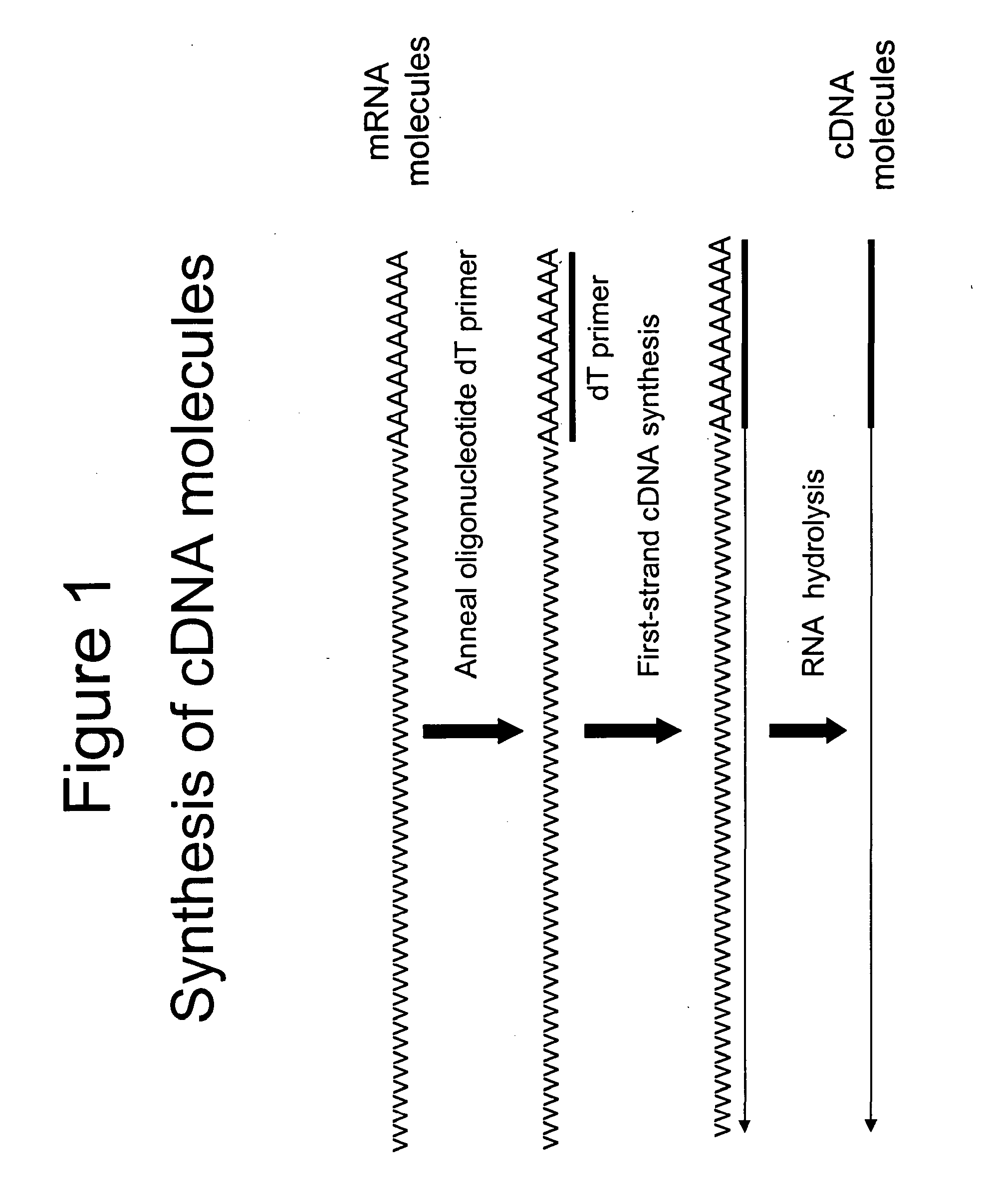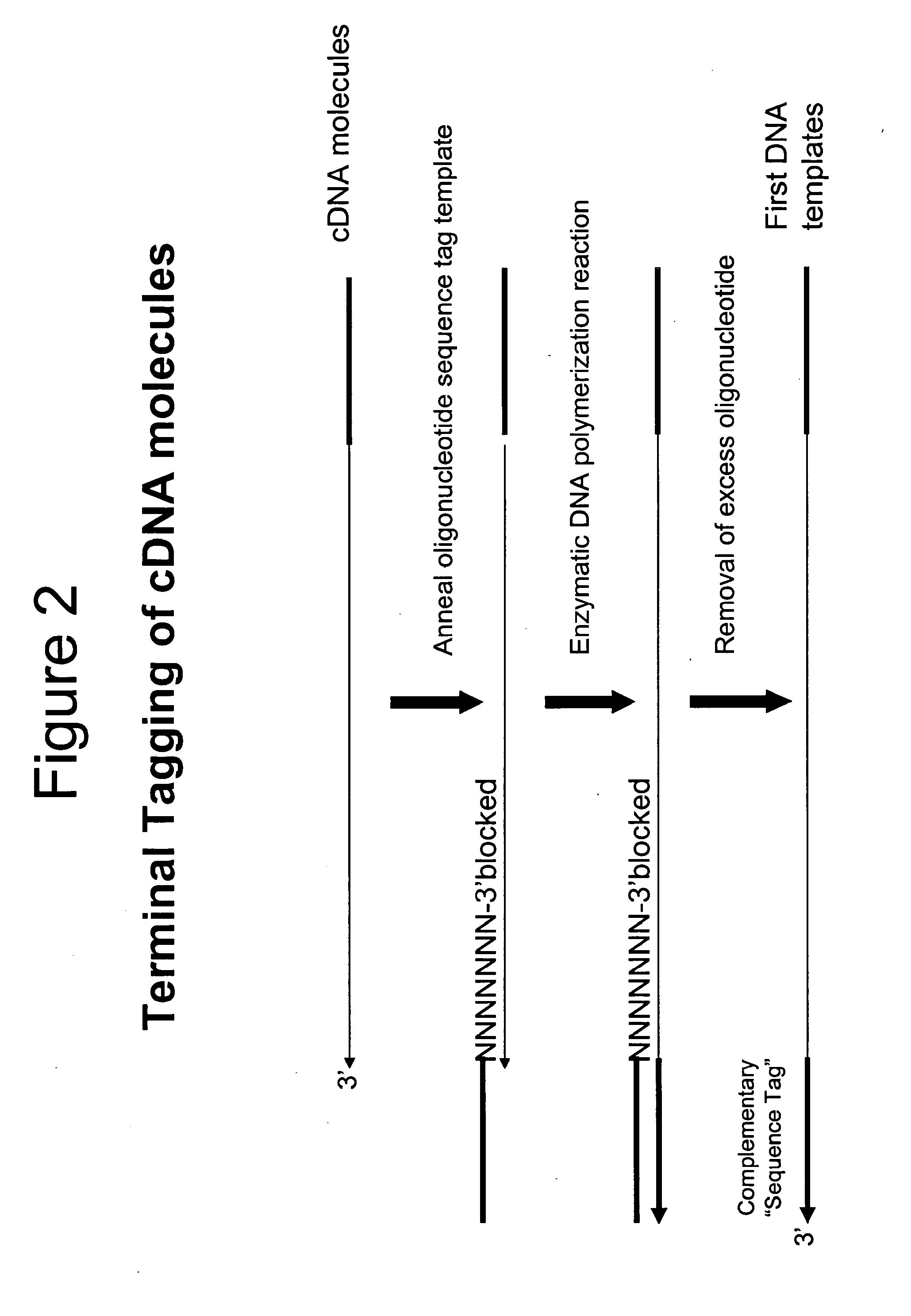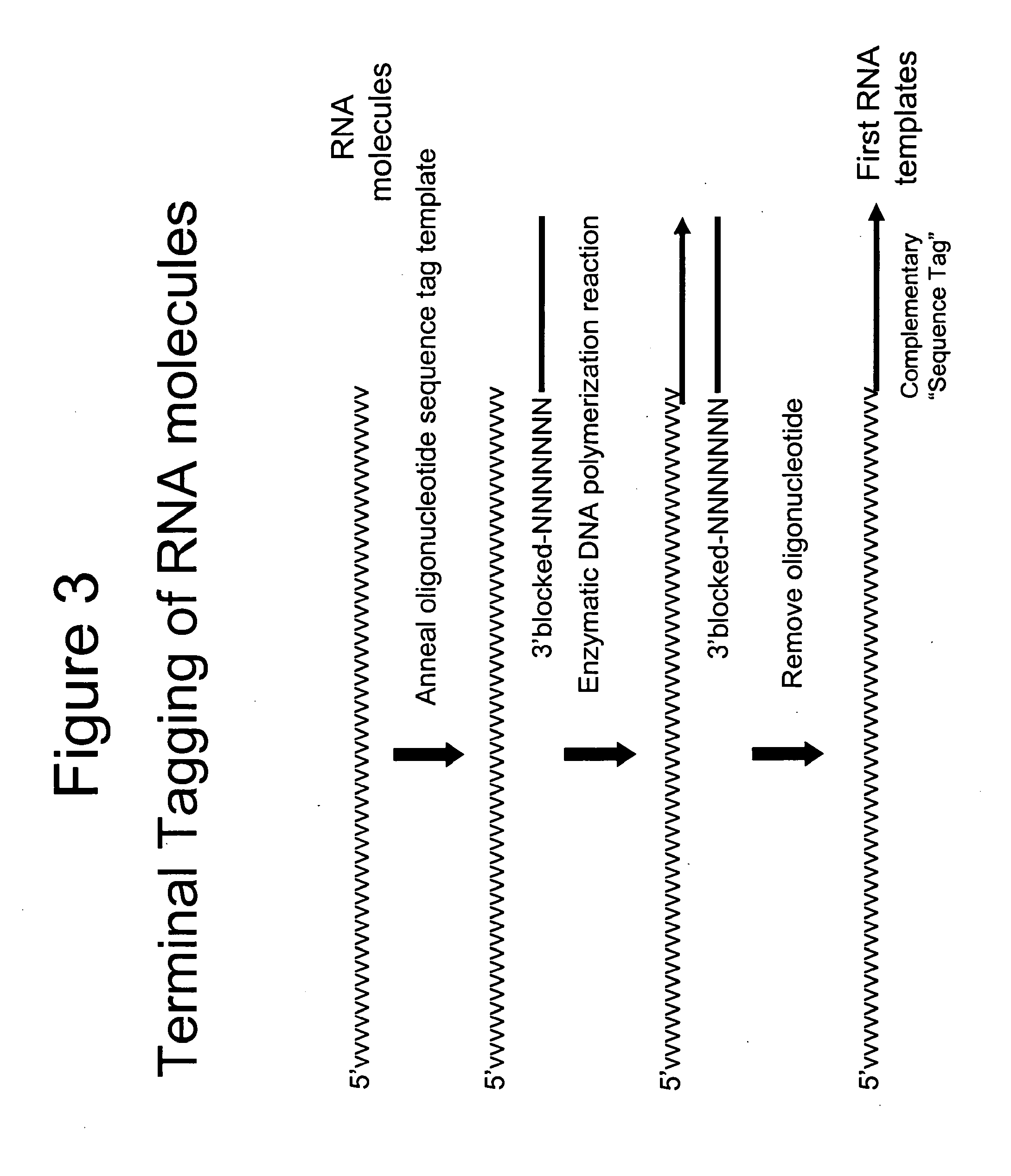Terminus-Specific DNA Modification Using Random-Sequence Template Oligonucleotides
a dna modification and template technology, applied in the field ofterminus-specific dna modification using random sequence template oligonucleotides, can solve the problems of loss of intact mrna, 5′ end of mrna, primer for second strand dna synthesis,
- Summary
- Abstract
- Description
- Claims
- Application Information
AI Technical Summary
Benefits of technology
Problems solved by technology
Method used
Image
Examples
example 1
Attachment of an Oligonucleotide Sequence Tag to the Terminal 3′ Ends of cDNA Molecules
[0042]Total RNA from mouse brain (Ambion) was repurified using the RNeasy procedure (Qiagen). The mRNA population contained in 4 μg of total RNA was used for making first-strand cDNA in a standard cDNA synthesis reaction containing 7.5 μM oligo dT primer (Seq. ID. No. 1; (dT)20V containing a 5′-Not I restriction endonuclease sequence in order to facilitate cloning), 10 mM Tris-HCl (pH 8.3), 50 mM KCl, 6 mM MgCl2, 5 mM DTT, 1 mM dATP, 1 mM dGTP, 1 mM dCTP, 1 mM TTP and a reverse transcriptase in a final volume of 20 μL. The reaction was allowed to proceed for 60 minutes at the recommended incubation temperatures. The RNA templates were then removed by enzymatic digestion with RNase A and H simultaneously, and the cDNA purified and recovered in 50 μL EB buffer (Qiagen) (see schematic of FIG. 1 for illustration).
[0043]The purified first-strand cDNA molecules were then divided into 2 equal aliquots an...
example 2
Transcription of the First DNA Templates
[0044]The DNA templates from each of the 2 reactions in Example 1 were used for priming DNA synthesis using a second oligonucleotide template containing a 5′ T7 promoter sequence (italicized) and a 3′ sequence tag complement (Seq. ID. No. 3; AATTCTAATACGACTCACTATAGGGAGACGAAGACAGTAGACA) to the sequence tag contained in the first DNA templates to form second DNA templates containing a T7 promoter sequence. The DNA synthesis reactions (50 uL) contained the respective DNA templates, 5 pmoles second oligonucleotide template (Seq. ID. No. 3), 40 mM Tricine-KOH (pH 8.7), 15 mM KOAc, 3.5 mM Mg(OAc)2, 3.75 μg / mL BSA, 0.005% Tween-20, 0.005% Nonidet-P40, 200 μM dATP, 200 μM dGTP, 20.0 μM dCTP, 200 μM TTP and 2 μL Advantage 2 Polymerase mix (BD Biosciences). The reactions were heated at 95° C. for 1 minute 30 seconds, 50° C. for 1 minute, 55° C. for 1 minute and finally, 68° C. for 30 minutes before phenol was added to terminate the reaction. In addition...
example 3
Amplification in PCR of Specific DNA Sequences Contained in a Library of First DNA Templates Using a First Primer Corresponding to the Oligonucleotide Sequence Tag and Gene Specific Second Primers
[0051]In vitro transcribed RNA (5 μg) generated in Example 2 containing the oligonucleotide sequence tag at its 5′ proximal end was reverse transcribed in a standard cDNA synthesis reaction (In Vitrogen) and the resulting first-strand cDNA was purified and reconstituted in 20 μL H2O. Four PCR amplification reactions were assembled, each containing 40 mM Tricine-KOH (pH 8.7), 15 mM KOAc, 3.5 mM Mg(OAc)2, 3.75 μg / mL BSA, 0.005% Tween-20, 0.005% Nonidet-P40, 200 dATP, 200 μM dGTP, 200 μM dCTP, 200 μM TTP and 2 μL Advantage 2 Polymerase mix in a final volume of 50 μL. To reactions 1 and 2, 20 picomoles of each of a forward primer (first primer) (Seq. ID. No. 4; TTGGCGCGCCTTGGGAGACGAAGACAGTAGA), which is complementary to the sequence tag on the 3′ proximal end of the synthesized cDNA and a gene ...
PUM
| Property | Measurement | Unit |
|---|---|---|
| temperature | aaaaa | aaaaa |
| pH | aaaaa | aaaaa |
| volume | aaaaa | aaaaa |
Abstract
Description
Claims
Application Information
 Login to View More
Login to View More - R&D
- Intellectual Property
- Life Sciences
- Materials
- Tech Scout
- Unparalleled Data Quality
- Higher Quality Content
- 60% Fewer Hallucinations
Browse by: Latest US Patents, China's latest patents, Technical Efficacy Thesaurus, Application Domain, Technology Topic, Popular Technical Reports.
© 2025 PatSnap. All rights reserved.Legal|Privacy policy|Modern Slavery Act Transparency Statement|Sitemap|About US| Contact US: help@patsnap.com



